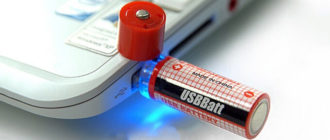The battery voltage can be used to judge the state of charge of the battery, so you should learn how to correctly determine this value at the terminals of the power source.
This article will describe the basic methods for measuring this parameter with a multimeter, and will also give reference values of voltage on batteries of various designs.
Content
Battery voltage under load
The battery voltage under load will be lower than at rest. By this indicator, you can also judge the health of the battery.
If after connecting the load plug the control device displays less than 9 V, then the battery is discharged and must be charged. If the situation does not change after repeating the procedure, then in the near future the battery will need to be replaced with a new one.
If it is not possible to use the load plug to test the battery under load, you can use a digital multimeter, and turn on the engine starter as the load.
If the voltage in the on-board network when the starter is turned on drops below 9 V, then in this case it will also be necessary to charge the battery using the charger. It is also worth checking the wiring elements and electricity consumers for serviceability.
If there is no leakage of electricity in the system, and when the battery is fully charged, an excessive voltage drop will again be observed, then the battery should be replaced.
If powerful consumers of electricity do not connect to the battery, then the voltage under a light load will not change too much.
Battery voltage no load
The voltage of the battery, to which electricity consumers are not connected, is 12.6 - 12.8 V. If the voltage at rest is less than this indicator, this will indicate that the battery is discharged or there is a short circuit in some banks.
Battery operation with a low charge level will certainly lead to the formation of lead sulfate on the plates, which will cause a significant drop in the capacity of the device.
To make accurate measurements of battery voltage without load, be sure to remove the terminals from the battery terminals immediately before connecting the meter.
Charged Battery Voltage
If the battery is fully charged, the voltage will depend on the battery model. If a normal antimony battery is used, then the minimum value of this indicator should be 12.6 V.
For a calcium battery, this indicator may be slightly higher, and on the terminals of the gel battery, this parameter should not fall below 13 V. If this indicator deviates from the norm, the battery must be charged with a current equal to 10% of the battery capacity.
If the battery voltage is measured while the engine is running, the readings will be much higher. With a working battery and a relay regulator, the voltage at the terminals can reach a maximum value of 14 V.
Normal battery voltage
The normal battery voltage is an indicator that is displayed in the documentation for the power source. If, when buying a new battery, it cannot be charged to the value specified in the instructions, then such a malfunction will be a warranty case.
If the relay-regulator and the generator are in good working order, the battery, during the operation of the machine, will be automatically charged to a normal level. It is advisable throughout the life of the battery to strive to use the battery only with normal voltage across the terminals.
With significant deviations of this parameter downwards in the winter season, the electrolyte in a discharged battery can completely freeze, and in the summer lead plates will be more intensively destroyed.
| Antimony and Hybrid Battery Charge Levels at Volts | |||||
|---|---|---|---|---|---|
| Temperature electrolyte | 100% | 75% | 50% | 25% | 0% |
| 48,9 | 12,663 | 12,463 | 12,253 | 12,073 | 11,903 |
| 43,3 | 12,661 | 12.,461 | 12,251 | 12,071 | 11,901 |
| 37,8 | 12,658 | 12,458 | 12,248 | 12,068 | 11,898 |
| 32,2 | 12,655 | 12,455 | 12,245 | 12,065 | 11,895 |
| 26,7 | 12,650 | 12,45 | 12,240 | 12,060 | 11,890 |
| 21,1 | 12,643 | 12,443 | 12,233 | 12,053 | 11,883 |
| 15,6 | 12,634 | 12,434 | 12,224 | 12,044 | 11,874 |
| 10 | 12,622 | 12,422 | 12,212 | 12,032 | 11,862 |
| 4,4 | 12,606 | 12,406 | 12,196 | 12,016 | 11,846 |
| -1,1 | 12,588 | 12,388 | 12,178 | 11,998 | 11,828 |
| -6,7 | 12,566 | 12,366 | 12,156 | 11,976 | 11,806 |
| -12,2 | 12,542 | 12,342 | 12,132 | 11,952 | 11,782 |
| -17,8 | 12,516 | 12,316 | 12,106 | 11,926 | 11,756 |
| The charge level of Calcium, AGM and GEL batteries at a voltage in Volts | |||||
|---|---|---|---|---|---|
| Temperature electrolyte | 100% | 75% | 50% | 25% | 0% |
| 48,9 | 12,813 | 12,613 | 12,416 | 12,013 | 11,813 |
| 43,3 | 12,811 | 12,611 | 12,411 | 12,011 | 11,811 |
| 37,8 | 12,808 | 12,608 | 12,408 | 12,008 | 11,808 |
| 32,2 | 12,805 | 12,605 | 12,405 | 12,005 | 11,805 |
| 26,7 | 12,8 | 12,6 | 12,4 | 12,0 | 11,8 |
| 21,1 | 12,793 | 12,593 | 12,393 | 11,993 | 11,793 |
| 15,6 | 12,784 | 12,584 | 12,384 | 11,984 | 11,784 |
| 10 | 12,772 | 12,572 | 12,372 | 11,972 | 11,772 |
| 4,4 | 12,756 | 12,556 | 12,356 | 11,956 | 11,756 |
| -1,1 | 12,738 | 12,538 | 12,338 | 11,937 | 11,738 |
| -6,7 | 12,716 | 12,516 | 12,316 | 11,916 | 11,716 |
| -12,2 | 12,692 | 12,492 | 12,292 | 11,892 | 11,692 |
| -17,8 | 12,666 | 12,466 | 12,266 | 11,866 | 11,666 |
Low Battery Voltage
If the battery voltage is less than 11.6 V, then the battery is considered completely discharged. In this case, the operation of the source of electricity is impossible and to restore its operability, it will be necessary to use a charger operating from a 220 V network.
Almost all lead batteries are sensitive to a full discharge. Calcium acid batteries can lose a significant part of their capacity even after a single deep discharge. Antimony device has great tolerance. The most resistant to full discharge are gel and AGM batteries.
Battery voltage in winter
In winter, constant undercharging of the battery can lead to a significant decrease in the density of the electrolyte, as a result of which the liquid inside the cans can freeze. Electrolyte freezing, in many cases, leads to a complete inoperability of the source of electricity. To prevent this from happening in the winter, the terminals should be at least 12.5 V.
If you are using a serviced battery model, the battery charge level can be controlled without using a voltmeter. It is enough to make regular measurements of the density of the electrolyte, which for a fully charged battery should be about 1.28 g / cm3.
Voltage versus electrolyte density
The battery level directly depends on the density of the electrolyte. If the battery is serviced, then the charge level can be fairly accurately measured without using a tester.
Using a hydrometer, the density is measured by picking up a small amount of electrolyte from each can of the device. The maximum density of a mixture of sulfuric acid and water in a fully charged battery is 1.3 g / cm3.
Adhere to this indicator if the machine is operated in cold weather. In summer, it can operate batteries at a density of 1.26 g / cm3 and higher. If a electrolyte density is within these limits, the voltage at the terminals will be about 12.7 V. When the density drops, a proportional decrease in the potential difference at the battery terminals occurs.
This indicator can decrease especially if there are leaks in the battery case through which part of the electrolyte will leak. It will be possible to restore the electrolyte level by adding distilled water.
How to check battery voltage with a multimeter
You can measure the operating voltage at the battery terminals with a voltmeter, which is one of the functions of the multimeter.
The battery is a direct current source, therefore, before starting the measurement work, the device should be switched to the “DC” position. A voltage limit of 20 V should also be established so that more accurate measurements can be made.
After proper preparation of the measuring device, it will be enough to connect the black probe with a minus, and the red one with the plus of the battery so that the device shows a DC voltage. If you mix the probes, the value will be negative.
Still have questions about battery voltage or have something to add? Then write to us about it in the comments, this will make the material more useful, complete and accurate.









